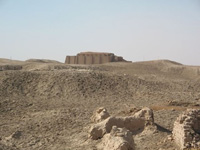Cultural heritage is unique and irreplaceable, which places the responsibility of preservation on the current generation. Whether it is art or monuments, tangible heritage is always at risk and nowhere is this seen to be truer than in Iraq (technically Afghanistan as well but that’s for another blog). Many are aware of the recent history of Iraq, strife with civil discord, war, and a nuclear power conflict, making the issue of protecting their cultural heritage trivial in the big scheme of issues currently at hand. However, Iraq is known as the "cradle of civilization," for a reason as it is a treasure trove of important archaeological sites including Babylon, Ur and Nimrud. These sites encompass an important part of Iraq's cultural heritage and they are in danger of being irreparably harmed; thereby making the trivial issue of Iraq protecting their cultural heritage a rather significant one.
Historically, Iraq has been home to continuous successive civilizations since the 6th millennium BC.. The area and people survived centuries of successive empires, multiple religious affiliations, and wars to become what John Stewart lovingly refers to as “Mess O' Potamia” today. Although you can disagree with the current politics occurring in and surrounding the country, you cannot disagree with the importance of preserving and researching the area for the benefit of humankind and history.
That is why I was surprised to read an article titled “Iraq protects its artifacts via satellite” in which the Iraq government is in the process of employing satellites to stop the historical sites from being looted and to reduce their vulnerability to random exploration. There are around 12,000 known archaeological sites across the country which go back to the Sumerians, Babylonians, Assyrians and Islamic civilizations. According to reports, around 170, 000 artifacts, including the Iraqi equivalent of Mona Lisa - the Sumerian girl's head, have been lost from Iraq not to be seen again.

Looters have descended upon many of these sites and are in the process of destroying them and extracting artifacts to sell to collectors and dealers. Past archaeological research is being destroyed in the process, as is the potential for future research. A series of international agreements has banned the trade in looted antiquities but these are inefficient with little to none legal holding. This why I wholeheartedly agree with the Iraq Tourism Authority’s plan to spend the next two years building walls around the archaeological sites and developing a specialized department that will control and monitor the areas using the satellite imaging.
All cultural heritage, whether it be sites, artifacts, or art, deserve to be preserved and accessible depending on their condition so future generations can enjoy and learn from them. That is why I enjoy working at the gallery because I feel like in some small way, by helping the art to find the right owner, the art can continue to be appreciated for generations to come and survive a little bit longer in this ever changing world.
